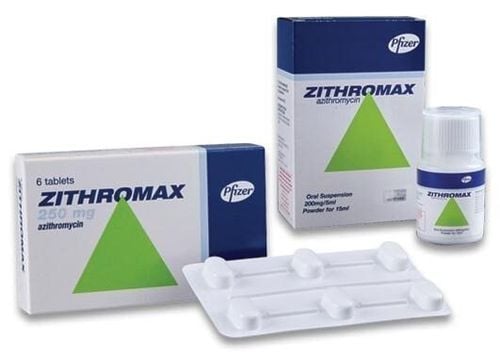This is an automatically translated article.
Zithromax contains Azithromycin, a broad-spectrum macrolide antibiotic with a long half-life and effective tissue penetration. Therefore, Zithromax is mainly used to treat infections of the respiratory tract, intestines and genitals.1. Introduction about Zithromax drug
Zithromax drug with the composition Azithromycin is a broad-spectrum macrolide antibiotic, with bacteriostatic activity against many Gram-positive and negative bacteria (including Bordetella pertussis, Legionella species). Furthermore, Zithromax is also active against Mycoplasma pneumoniae, Treponema pallidum, Chlamydia species and Mycobacterium avium complex.The mechanism of action of Azithromycin is through reversible binding to bacterial ribosomes and inhibition of protein synthesis. The drug has an absolute oral bioavailability of 35-42% in healthy volunteers and also in subjects with cystic fibrosis. The half-life is long due to extensive absorption in the tissues, especially the lungs, tonsils and prostate. Tissue concentrations in excess of the minimum inhibitory concentration 90% of pathogenicity (MIC90) after a single oral dose of 500 mg. Mean tissue concentrations of Zithromax are 10–100 times higher than those achieved in serum and may persist for several days. Besides, the effect of Azithromycin also accumulates in phagocytic cells, the concentration is 200 times greater than in serum, but it penetrates poorly into the cerebrospinal fluid and peritoneal fluid.
2. What is the effect of Zithromax?
Indications to use Zithromax in infections, including:
Community-acquired pneumonia; Respiratory tract infections, including whooping cough and legionella (disease caused by Legionella bacteria); Sexually transmitted infections such as orchitis, pelvic inflammatory disease, cysts and granulomas in the groin; Enteritis caused by Campylobacter and Salmonella species, cholera and traveler's diarrhea as well as infectious diarrhea caused by Salmonella enterica serovar Typhi and S. enterica serovar Paratyphi. Other recommended uses of Azithromycin include treating severe infections or persistent lymphadenopathy caused by Bartonella henselae (cat scratch disease) and certain tick-borne infections such as tick typhus. In addition, Zithromax is also used as part of combination therapy for complex infections caused by M. avium.

Thuốc Zithromax được chỉ định trong một số trường hợp nhiễm trùng
3. Uses of Azithromycin as an immunomodulator
In addition to the antibacterial properties of the commonly used drug Zithromax, Azithromycin has in vitro and animal data on the immunomodulatory or anti-inflammatory effects of Macrolid. The effects of Azithromycin in humans were initially reported in the treatment of diffuse bronchiolitis, where Macrolid was associated with improved lung function and prognosis.
In cystic fibrosis, treatment with Azithromycin for 6 months has been shown to improve respiratory function and reduce exacerbations of respiratory failure. Furthermore, Azithromycin resulted in an increase in lung function (mean 8.8%) after 7 months in patients treated for bronchiolitis obliterans syndrome after lung transplantation.
On the other hand, the immunomodulatory effects of Azithromycin and other macrolides have also been suggested for use in sepsis and epidemic respiratory tract infections to suppress the cytokine storm. This is the basis that distinguishes this antibiotic that has been used for various respiratory and non-respiratory inflammatory conditions. However, this use is controversial due to limited direct clinical evidence for many diseases and concerns about the subsequent increase in antibiotic resistance. Accordingly, only macrolides without antibiotic properties can provide sustained immunomodulatory benefits without contributing to future antibiotic resistance.
4. How to use Zithromax?
Zithromax or Azithromycin is usually used orally, with capsules or suspension like Zitromax 200mg/5ml for children. In addition, Zithromax is also available as an intravenous drug for patients who cannot tolerate oral medications.
The duration of treatment with Zithromax varies depending on the indication and severity of the disease. Usually, a single dose of Zithromax is recommended in certain sexually transmitted infections. A regimen of several days of Zithromax is usually appropriate for respiratory tract infections and months for infections caused by mycobacterium or for immunomodulatory purposes.
Unlike Clarithromycin, which belongs to the same class of antibiotics, Azithromycin does not interact significantly with cytochrome P450 3A4. Besides, compared to Erythromycin, Azithromycin is also more resistant to acids, which simplifies the use of drugs around meals.
Azithromycin belongs to the B1 drug class for pregnant women and should be considered safe to use during pregnancy and breast-feeding. However, this antibiotic can sometimes cause diarrhea in breastfed babies.
5. Side effects when taking Azithromycin
Azithromycin is generally well tolerated but adverse events are relatively common (1–5% of patients), including gastrointestinal discomfort, headache, and dizziness. Transient elevations in blood transaminases have also been reported in 1.5% of patients.
Hearing loss or impairment has also been reported as a side effect of Azithromycin, including in patients with chronic obstructive pulmonary disease (COPD) and normal hearing at baseline, sometimes seemingly impossible. recovery in a small number of patients.
Serious side effects with azithromycin are QT prolongation and torsades de pointes leading to death. Therefore, caution should be exercised when azithromycin is used in patients with a history of cardiovascular disease and the risk of fatal arrhythmias should be considered in those who: have prolonged QT interval (including congenital long QT syndrome), are taking drugs (cardiovascular and non-cardiovascular) with the potential to prolong the QT interval or a history of torsades de pointes, arrhythmias, or decompensated heart failure.

Thuốc Zithromax có thể gây ra một số tác dụng phụ cho người bệnh
6. Clinically significant drug interactions with Azithromycin
Azithromycin has several clinically relevant drug interactions. Due to the long half-life, drug interactions may continue for several days after drug discontinuation. Azithromycin should be used with extreme caution if used concomitantly with other drugs that prolong the QT interval as further QT prolongation may be possible. There are some published reports suggesting that azithromycin may increase the activity of warfarin. Therefore, INR should be carefully monitored in patients taking warfarin. Pharmacokinetic modeling has shown that azithromycin reduces the clearance of everolimus. Macrolides, including azithromycin, may increase the toxicity of digoxin. Azithromycin can increase the concentration of colchicine, thus increasing the toxicity of the drug. Concomitant use of statins and azithromycin may increase the risk of rhabdomyolysis. Concomitant administration of antacids (aluminum, magnesium) may decrease peak azithromycin concentrations. The pharmacokinetics and tolerability of Azithromycin or Zithromax have made this antibiotic particularly useful in the treatment of respiratory, sexual, and gastrointestinal infections and for the prevention of mycobacterial diseases. Moreover, the drug Zithromax also has an immunomodulatory effect despite the concern about the risk of antibiotic resistance. However, the use of zithromax or any other antibiotic should always be followed by a doctor's prescription to ensure effective treatment as well as safety for the patient.
Please dial HOTLINE for more information or register for an appointment HERE. Download MyVinmec app to make appointments faster and to manage your bookings easily.
References: ncbi.nlm.nih.gov, thelancet.com












